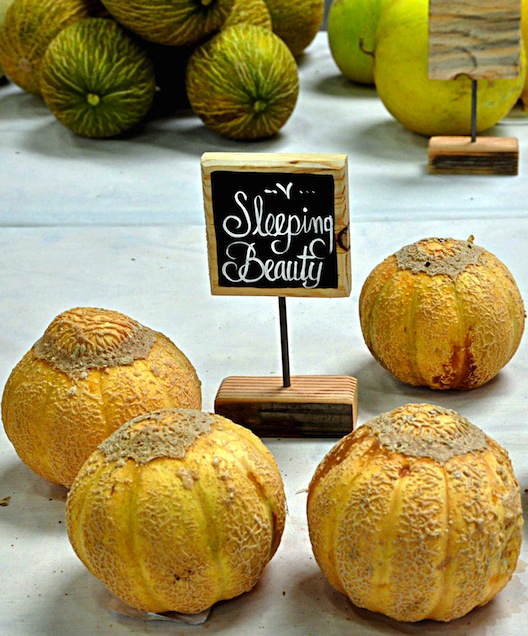At the recent Heirloom Expo in Santa Rosa, I was bouncing back and forth between the displays of melons when I was distracted from the many, many different varieties by a woman talking to a group of children, all probably around 7-8 years old. She was holding a melon that looked cantaloupe-esque, heavily netted, with a faint orangey glow, but instead of a round orb this one grew a little bulb on one end, a cantaloupe crossed with a brioche pastry! It was innocently labeled “Sleeping Beauty.”

“Here, smell this one. Put your nose right here and take a big sniff.” The kid in front of her did not hesitate at all, he dove right in with his nose, greeting the unknown scent awaiting him with reckless abandon. His eyes got wide as he inhaled, and his adult guide smiled knowingly. An appreciative noise was all he used to describe the delicious aroma and the declaration that he would like to eat that one. The other children in the group jostled for a chance to smell this tantalizing melon. When they started clamoring to actually eat the melon, their teacher reminded them that while they would get to try fruit later in the day, right now they were here to think about how all the melons were unique, to consider their size, shape, smell, feel, color, etc.
They had their work cut out for them. There were tables after tables of different melons. Then their was the squash, which you could admire in a mountain piled high at the entrance of the room, each warty, clown-colored character waiting to pop out from the hillside with a Jim Henson puppet attached and a song to match. The squash landscape extended out from the mountain in flows of the bulbous jokers down the lengths of many tables. Beyond those vistas were plains of tomatoes, apples, pears, peppers, flint corn, dried beans, the options continuing until they faded into the distant edges of the large hall. All of them heirlooms varieties and all of them unique in some way.
The word ‘heirloom’ when applied to crops is not clearly defined, but most agree that the organism must at least be an open-pollinated variety and that the variety is not a result of genetic modification in a laboratory. There are hundreds of identified varieties of our common food crops that are considered heirlooms and are still in production, but there are many more hundreds of varieties that have slipped away from us, the seeds and knowledge lost forever, or maybe (hopefully) buried in the depths of someone’s cellar for now. Preserving what we have left of the heirloom varieties could help us tackle several of the big issues we are currently grappling with: biodiversity, cultural diversity, health, economic security, and greater food security. However, that glimpse of children smelling the melon, of them learning to approach a piece of produce with all of their senses, gave me something new to consider as I moved through the displays at the expo.
Perhaps interacting with these different varieties helps us to be more fully human. They give us the rare opportunity to be firmly present while we consider their differences from one another, and from their distant cousins that we usually see in the grocery store. Using all of our faculties to participate with another organism, a little piece of the natural world, allows us to more thoroughly engage with our own existence. What do I do with this? Is it sweet? Firm? Creamy fleshed? How do I tell when it is ripe? We become involved in an age old conversation that our bodies viscerally understand.
Happily, we can all be a part of safeguarding this opportunity for both ourselves and others. It is a simple matter of searching out these heirloom varieties, eating them, encouraging your farmers to grow them, trying a new one in your garden every year, and maybe even saving some seed. We need no fancy laboratories, or complicated liquid nitrogen storage cells to preserve their genetics. Nope, armed with an open mind, and a willingness to explore, we become warriors to preserve the genetic diversity that may help us be more thoroughly ourselves.
–Erin Walkenshaw, Full Belly Intern
